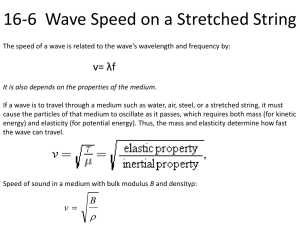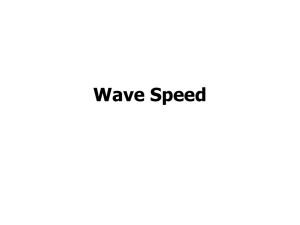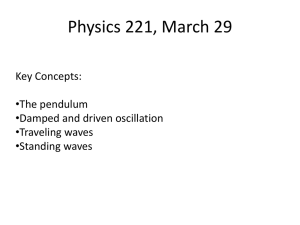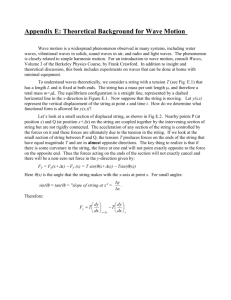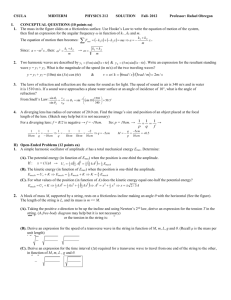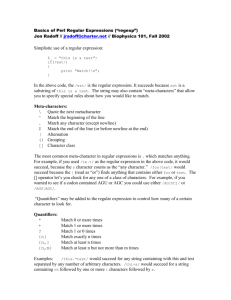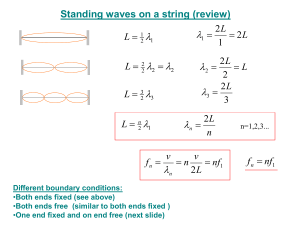phys275-AppendixE
advertisement
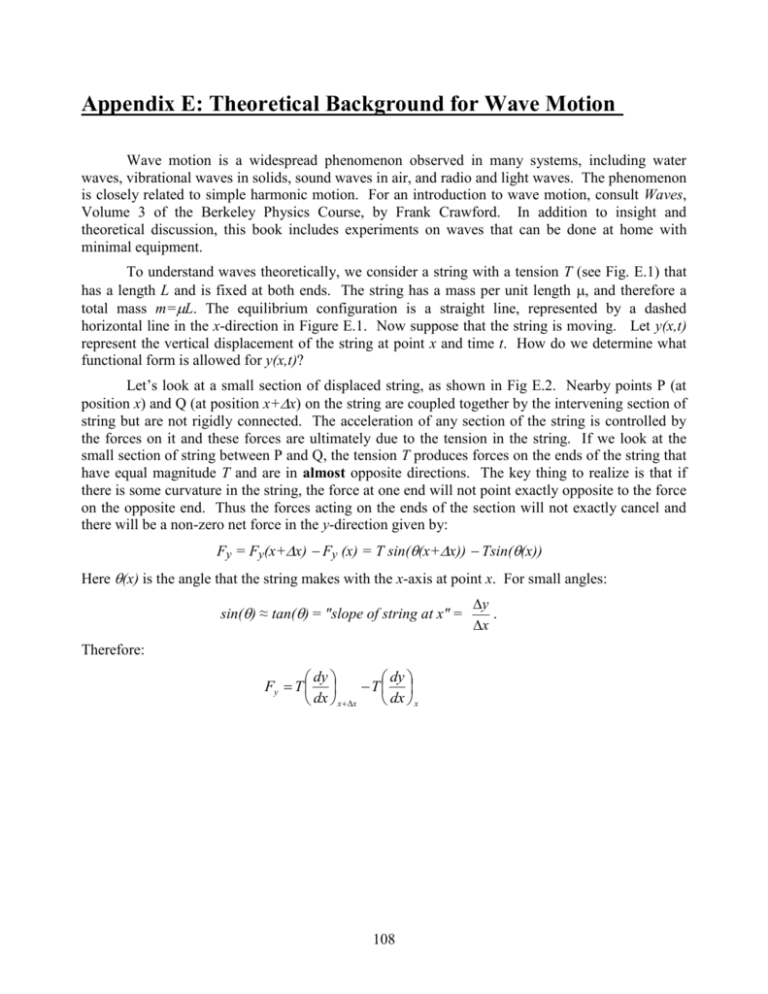
Appendix E: Theoretical Background for Wave Motion Wave motion is a widespread phenomenon observed in many systems, including water waves, vibrational waves in solids, sound waves in air, and radio and light waves. The phenomenon is closely related to simple harmonic motion. For an introduction to wave motion, consult Waves, Volume 3 of the Berkeley Physics Course, by Frank Crawford. In addition to insight and theoretical discussion, this book includes experiments on waves that can be done at home with minimal equipment. To understand waves theoretically, we consider a string with a tension T (see Fig. E.1) that has a length L and is fixed at both ends. The string has a mass per unit length , and therefore a total mass m=L. The equilibrium configuration is a straight line, represented by a dashed horizontal line in the x-direction in Figure E.1. Now suppose that the string is moving. Let y(x,t) represent the vertical displacement of the string at point x and time t. How do we determine what functional form is allowed for y(x,t)? Let’s look at a small section of displaced string, as shown in Fig E.2. Nearby points P (at position x) and Q (at position x+x) on the string are coupled together by the intervening section of string but are not rigidly connected. The acceleration of any section of the string is controlled by the forces on it and these forces are ultimately due to the tension in the string. If we look at the small section of string between P and Q, the tension T produces forces on the ends of the string that have equal magnitude T and are in almost opposite directions. The key thing to realize is that if there is some curvature in the string, the force at one end will not point exactly opposite to the force on the opposite end. Thus the forces acting on the ends of the section will not exactly cancel and there will be a non-zero net force in the y-direction given by: Fy = Fy(x+x) Fy (x) = T sin((x+x)) Tsin((x)) Here (x) is the angle that the string makes with the x-axis at point x. For small angles: sin() ≈ tan() = "slope of string at x" = Therefore: dy dy Fy T T dx xx dx x 108 y . x Figure E.1 At point P (position x) the string is displaced a distance y from equilibrium (dashed line). Figure E.2 Detailed view of a small section of the string between points P and Q. For the element of string of mass m=µx. we can use Newton's second law to write the equation of motion in the vertical direction as: m dy d2y d2y dy x T 2 2 dt dt dx xx dx x Dividing through by Tx and taking the limit x 0, one finds: d2y d2y dx 2 T dt 2 1 d2y vs dt 2 [E.1] where: vs T is the "wave speed" [E.2] Equation E.1 is the wave equation for a string. Here we have identified the constant T/µ as 109 vs2, a constant which we will see is the square of the wave speed vs. There are some general remarks that can be made about the solutions to Equation E.1. In general, ANY smooth function f whose arguments are combinations of x and t in the form x±vst is a solution. Thus y=f(x±vst) is the general solution to the equation when f is ANY well-behaved function of x±vst. This can readily be shown by substituting back into equation E.1 and performing the corresponding derivatives. The Wave Speed To understand why the wave speed is given by vs, consider the case where the displacement of the string is of the general form f(xvst). At the point xo at time to the displacement is thus f(xovsto)=f1. Notice that at a later time t, the point x will have exactly the same displacement f1=f(xvst)=f(xo-vsto) if we choose x such that: x vst = xo vst0 x = xo+ vs(tto) Thus, the displacement that was at xo has moved a distance vs(tto) further down the string in a time tto. Since there is nothing special about xo, this is true for all points on the string. Thus the wave is moving with a speed vs down the string. Sinusoidal Waves Although in general f can be any well-behaved function, many properties of wave motion are most easily analyzed if we use sine and cosine functions for f. This is derived in many physics textbooks: here we will just show that the form y ( x, t ) A sin( kx t ) E.3 is a solution by taking the appropriate derivatives: d2y 2 A sin( kx t ) 2 dt and d2y k 2 A sin( kx t ) 2 dx E.4 2 . This allows us to T relate the “wave number”, k, and the angular frequency, to the wave speed vs. The wave number 2 k is related to the wavelength : . Combining these two equations by using equation E.1 we then have k2 Standing Waves In our Physics 275 experiment, the string is fixed at both ends and has a total length L. A wave is induced by a small oscillation at the near end of the string. The wave described in equation E.3 travels from the near end to the far end, and when it reaches the far end it is reflected back and inverted because of the fixed end. Because of the superposition principle, these two waves are combined so that the resultant function is 110 y ( x, t ) y1 ( x, t ) y 2 ( x, t ) A sin( kx t ) A sin( kx t ) (2 A sin kx) cos t E.5 This is the expression for a standing wave. Note that the x-dependence of the wave is now completely separated from the time-dependence. So every little portion of the string will appear to oscillate up and down with an amplitude that varies along the length of the string. The maximum amplitude is 2A and the minimum amplitude is 0. The “nodes” of the standing wave are the locations where the amplitude is 0, and are when kx = , 2, 3, …, or when n x , n 0,1,2,3, 2 This expression not only tells us where the nodes will be located, but also what wavelengths will satisfy the standing wave criterion for a string of length L, using the fact that we require the amplitude of the wave to be 0 at x=0 and x=L. 2L n , n 1,2,3, E.6 n Figure E.3 shows the first few allowed standing waves for a string of length L. Figure E.3: The three lowest standing waves for a string fixed at both ends. The fundamental has no nodes, the first harmonic has 1 node, and the 2nd harmonic has 2 nodes. From E.6, and from the equation for the wave speed E.2, we can determine the frequencies that will correspond to standing waves on the string: f 2 kvs 2 vs n n v s , n 1,2,3, 2L The allowed frequencies are just integer multiples of the fundamental frequency f1=vs/2L. So from knowing the tension in the string and its mass per unit length we can predict the resonant frequencies we should expect to see. Conversely, by measuring the allowed frequencies the length of the string, and the mass per unit length of the string, we can predict the wave speed of the string and determine its tension. This technique is sometimes used to determine the string tension in particle and nuclear physics detectors called wire chambers. Stringed-instrument musicians also use this technique to adjust the tension in the strings to give a desired pitch (where their well-tuned ears measure the frequency.) 111

